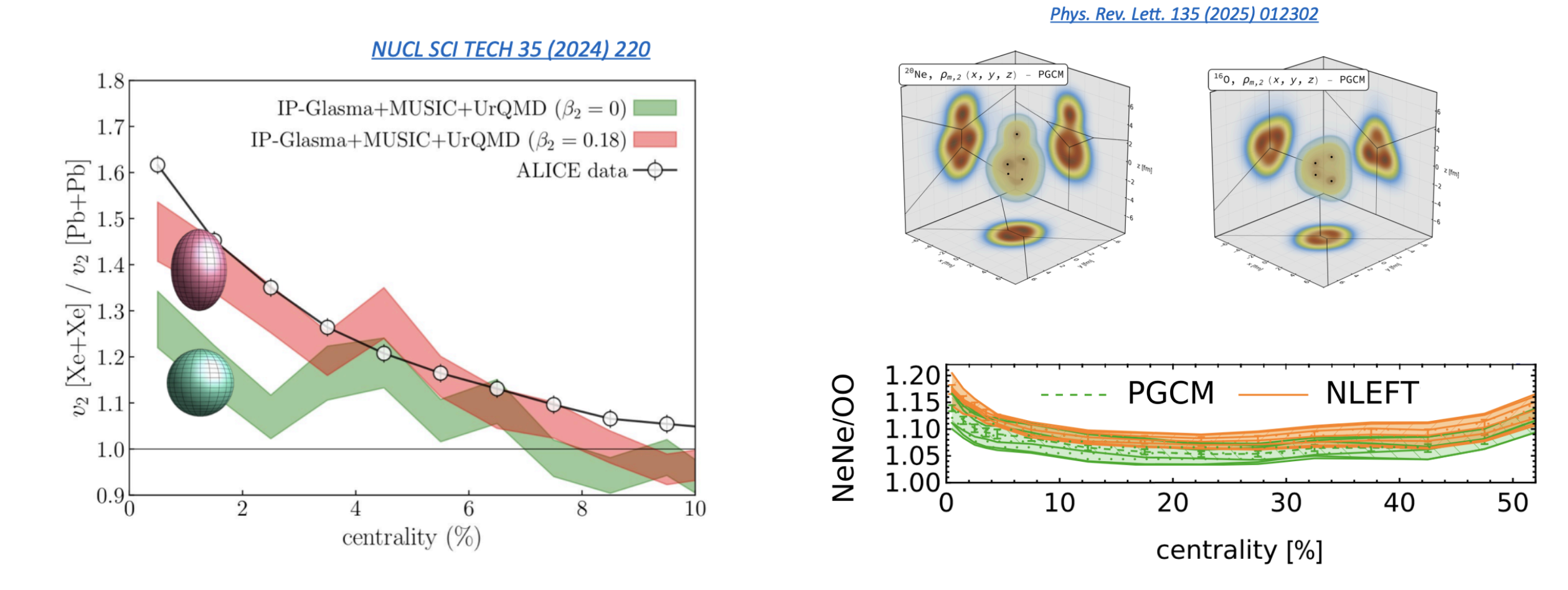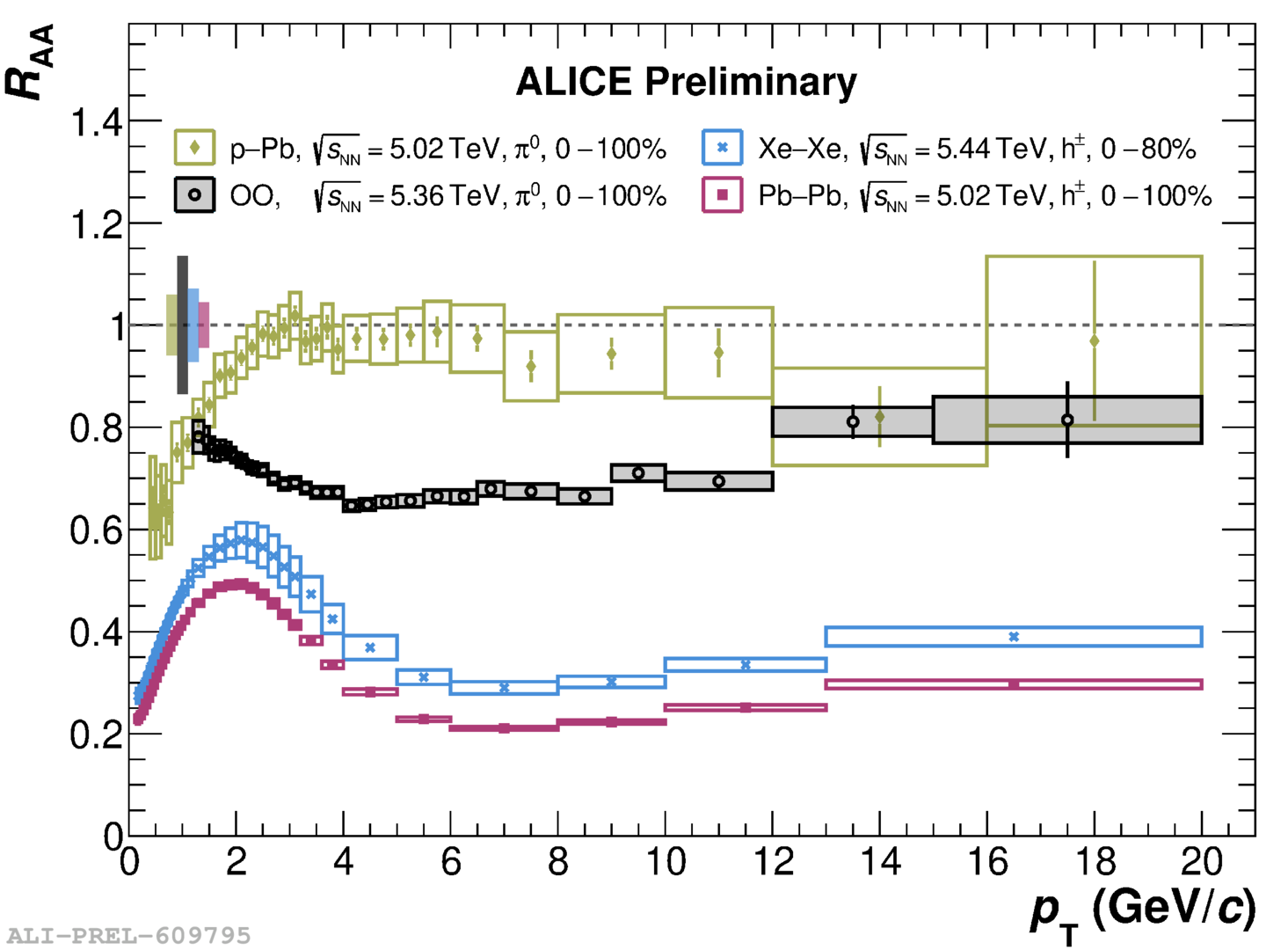ALICE explores the quark–gluon plasma with light-ion collisions

In July 2025, the ALICE experiment took part in the LHC’s first-ever light-ion campaign, colliding oxygen–oxygen (O–O) and neon–neon (Ne–Ne) nuclei at a centre-of-mass energy of 5.36 TeV per nucleon pair. The short but intense runs offered a rare opportunity to explore the transition between ordinary hadronic interactions and the conditions that may give rise to the quark–gluon plasma (QGP) — a state of deconfined quarks and gluons believed to have filled the early Universe shortly after the Big Bang.
Light-ion collisions occupy an intermediate regime between proton–proton and lead–lead systems, allowing physicists to tune the size and density of the collision system and study how collective behaviour develops as a function of system size. With its excellent tracking, particle identification, and low-momentum reach, ALICE is ideally equipped to explore such small systems.
Collective dynamics in light ions
Early analyses of the 2025 data indicate that both O–O and Ne–Ne collisions exhibit collective flow patterns, similar to those seen in heavier nuclei. Using two- and multi-particle correlation techniques, ALICE observes a clear hierarchy among the flow harmonics, v2 > v3 > v4, consistent with hydrodynamic expectations. The magnitude of elliptic flow (v2) increases with event multiplicity, suggesting that azimuthal anisotropy and collective dynamics persist even in these small nuclear systems. Comparisons between oxygen and neon further highlight the role of nuclear structure: neon’s intrinsic deformation — often described as a “bowling-pin” geometry — appears to enhance its elliptic flow relative to oxygen.
ALICE has also reported identified-particle flow for pions, kaons, and protons, showing a characteristic mass ordering — heavier particles exhibit smaller flow at low transverse momentum — a well-known signature of collective expansion. The measurements are compared with TRENTo+MUSIC and IP-Glasma+Hydro models, which reproduce the overall trends, though small differences in the flow magnitudes and centrality dependence suggest that quantum fluctuations and initial geometry effects remain important ingredients in the modelling.

Figure 1. Anisotropic flow predictions and measurements for oxygen–oxygen and neon–neon collisions at the LHC. Hydrodynamic calculations using a QGP equation of state reproduce the observed flow hierarchy, with differences between O–O and Ne–Ne reflecting the influence of nuclear geometry and low-energy structure models such as PGCM and NLEFT. Image: ALICE Collaboration
Imaging the structure of light nuclei
Beyond collective flow, the ALICE data also provide new sensitivity to nuclear structure effects. By comparing elliptic-flow ratios such as v2(Ne–Ne)/v2(O–O), researchers can test how the intrinsic geometry of nuclei shapes the final-state particle distributions. These comparisons are sensitive to the deformed structure of the ^{20}Ne nucleus, as predicted by state-of-the-art nuclear models.

Figure 2. Imaging the 20Ne nucleus through collective flow measurements at the LHC. The observed elliptic-flow ratio v2(Ne–Ne)/v2(O–O) provides sensitivity to nuclear geometry, with model comparisons (PGCM and NLEFT) indicating the characteristic deformed “bowling-pin” structure of neon. Image: ALICE Collaboration
Exploring jet-quenching effects in oxygen–oxygen collisions
One of the central questions of the 2025 campaign is whether jet-quenching phenomena — a hallmark of QGP formation — can also appear in small nuclear systems. ALICE has measured the production of high-transverse-momentum neutral pions in O–O collisions and derived the nuclear modification factor, RAA. The first results, presented only weeks after data taking, suggest a suppression pattern relative to proton–proton collisions at the same energy. The magnitude and pT dependence of the suppression appear similar to those seen in larger Xe–Xe and Pb–Pb systems, while contrasting with the near-unity RAA observed in p–Pb. These early observations provide initial evidence that energy-loss effects may also play a role in oxygen–oxygen interactions.

Figure 3. Nuclear modification factor (RAA) of neutral-pion production in oxygen–oxygen collisions, compared to previous charged-hadron measurements in Xe–Xe and Pb–Pb collisions. While no significant suppression (RAA ≈ 1) is observed at high pT in p–Pb collisions, a moderate suppression is seen for neutral pions in O–O. The trend suggests that the strength of jet quenching increases with the size of the colliding ions. Image: ALICE Collaboration
Probing the oxygen nucleus
Beyond quark–gluon plasma signatures, O–O data offer a complementary view of the ^{16}O nucleus itself. Modern descriptions treat the oxygen wave function as a quantum superposition of configurations, potentially including alpha clustering. Because O–O interactions occur on ultrashort time scales, they can effectively “sample” these configurations event by event, mapping the initial spatial density into final-state momentum anisotropies. Comparisons with models such as TRENTo and NLEFT can help quantify the contribution of different nuclear configurations. Additional sensitivity comes from the Zero Degree Calorimeters (ZDCs), which detect spectator nucleons; enhanced clustering is predicted to increase the spectator yield.
Together with accompanying proton–oxygen collisions — essential for providing a reference and for improving atmospheric-interaction models relevant to cosmic-ray physics — the oxygen programme establishes a powerful link between heavy-ion, small-system, and astroparticle physics.
For curious readers
- Slides: First results from light-ion collisions by ALICE (Anthony Timmins, 16 September 2025). View the presentation on the Indico page.
Cover image: Light-ion collisions recorded by ALICE at 5.36 TeV. Oxygen–oxygen and neon–neon systems bridge the gap between proton–proton and lead–lead, enabling controlled studies of collective dynamics in small nuclei. Image: ALICE Collaboration / CERN
